Baselayers are the first step towards beating the cold and it’s vital that you get your layering system spot on before heading outdoors.
Follow our expert guide and nail it every time.

What is a baselayer?
A baselayer is a skin-hugging garment designed to be worn underneath other layers of clothing during various activities, including running, cycling and skiing.
Baselayers can be pricey, which is why people are often tempted into wearing cotton layers. This isn't a good idea though, because cotton absorbs moisture and is far less durable than synthetics or wool. The moisture wicking performance of an active baselayer is key as it allows the skin to breath while providing excellent levels of insulation.

What fabrics are baselayers made from?
Synthetic:
The most common baselayer fabric is polyester. This, and other man-made synthetics will generally be cheaper than other fabrics, which is why they’re often found in entry-level products.
Don't let that put you off though. They’re lightweight, durable and more than adequate for most activities such as running and cycling. Synthetic baselayers will normally incorporate anti-bacterial technology too for effective odour control.
Some higher quality baselayers will be manufactured using synthetic/wool blends to produce a softer fabric that boasts improved moisture wicking capabilities.
Merino wool:
Not only are Merino wool baselayers softer than synthetic counterparts, they offer superior levels of insulation and breathability too.
Taken from the Merino sheep breed, this particular type of wool is naturally lightweight, stretchy and breathable – perfect for constructing high-performance baselayers.
Unsuprisingly, Merino wool baselayers are more expensive than polyester equivalents, but the difference in quality is immediately apparent, especially when you feel how soft the fabric is.
You’ll be pleased to know that Merino wool fibres are naturally antibacterial as well, so unpleasant odours can be kept at bay for longer when you’re working up a sweat.

Bamboo:
Bamboo is the new kid on the block when it comes to baselayer fabrics. This eco-friendly option is created using a blend of bamboo extracts and cotton, Lycra or wool. The result is a high performance material that provides all the warmth, flexibility and moisture control you need from a baselayer.
Bamboo baselayers are also renowned for being delicate on skin, making them the ideal choice if you are sensitive to other fabrics such as wool or polyester.
How thick should a baselayer be?
As a general rule, thickness determines warmth. The thicker (heavier) a baselayer is, the more insulation it will provide. Products normally fall into one of three categories; lightweight, midweight and heavyweight.
Lightweight:
A lightweight baselayer is designed to sit tight to the skin, giving you unrivalled levels of breathability and moisture wicking without impacting mobility. They're best used for vigorous activity in cool conditions.
Midweight:
Midweight baselayers offer more versatility, allowing you stay a touch warmer without sacrificing too much in the way of flexibility and breathability.
Worn on its own, a midweight layer is great for moderate exercise in cold conditions. If extra warmth is needed, you can slip it on over the top of a lightweight baselayer.
Heavyweight:
Heavyweight baselayers are less likely to be worn as the first layer, instead, they are usually combined with lighter layers underneath to lock in body heat. They aren’t as breathable as lightweight or midweight versions, but they’re the best choice if you’re heading out in sub-zero temperatures.
When should I wear a baselayer?
There are lots of ways to make use of baselayers, just adapt your layering system to complement the activity and weather conditions.
Recommended use:
Mountain sports (skiing, snowboarding etc.) – body temperature control in cold mountain climates
Cycling – lightweight and aerodynamic
Walking and running – unrestrictive insulation

How should a baselayer fit?
A tight fit is essential in order for baselayers to work effectively. Skin-tight layers block out the cold while transferring moisture away from the body through evaporation. The result is a perfect balance of comfort, warmth and freshness.
Heavyweight baselayers are often looser fitting, to allow room for additional layers underneath.
Tops:
There’s no need to order a smaller size to achieve a tight fit, just stick with your normal t-shirt size. Pick a long sleeve, short sleeve or sleeveless version depending on what sort of coverage you’re after.
Bottoms:
You should aim for a skin-tight fit when choosing baselayer bottoms too. The fabrics are designed to stretch, so leg movement isn’t restricted when you’re out running, hiking, cycling or skiing.
Baselayer bottoms are also a great companion to your daily leisurewear. Wear them under casual clothes for some extra warmth when it’s Baltic outside.
Cleaning your baselayers
Baselayers do a great job drawing sweat away from the body, but unless cared for, unpleasant odours can work their way into the fabric. The good news is that there are loads of really effective cleaners and conditioners that you can use to disperse bad smells and protect against future manifestations.
Don’t let the cold stop you getting active this winter. Grab a decent set of baselayers and get out there!




Comments